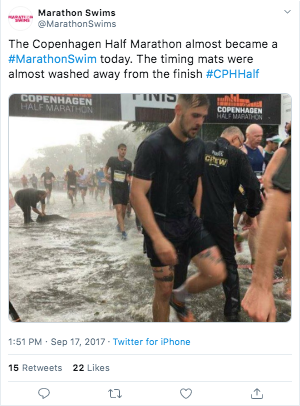Runner vs. Planet: When global climate change outpaces running events
According to the United Nations Sustainable Development Goal 13—”Take urgent action to combat climate change and its impacts”—severe weather is becoming more and more frequent.
Rising temperatures and sea levels have led to changing weather patterns, which sometimes makes winter last longer, the summer heat start earlier, and storms or droughts more intense.
And of course, it’s made it more intense to be an outdoor runner, as many of us have already experienced. It’s shaken up training regimens and has led to the cancellation of major races. With the impacts of global climate change expected to escalate, it’s likely the sports world – and running events in particular – are going to come up against more hurdles.
Here’s a round-up of some of the more severe weather patterns that have affected major running events – so far.
The Cancelled Running Events
New York City Marathon, November 4, 2012
Cancelled due to Hurricane Sandy
Sandy was the deadliest hurricane of 2012, claiming the lives of 233 people from Oct. 29 to Nov. 2, 2012. It was also incredibly destructive, primarily damaging the city of New York, although the Caribbean, and even Canada, also suffered from it.
Although organizers tried their best to get its 50,000 runners to the start line, the event was cancelled only two days before race day. Mary Wittenberg, director of the marathon, told the New York Times it was one of the toughest decisions her organization had ever made. “It’s clear that the best thing for New York and the best thing for the marathon and the future is, unfortunately, to move on,” she said.
MetroPCS Dallas Marathon, December 8, 2013
Cancelled due to “Icepocalpse”
An ice storm in Texas? Yep. Hundreds of thousands of people lost electricity two weeks before Christmas and Dallas streets were undriveable (and unrunnable) due to a mutation of ice and sand that created jostling and slippery potholes. The 20,000 registered racers had to be turned away, but it didn’t stop about 30 “renegade” runners from running the sloppy course anyway. “I just trained for so long, I just feel like doing it,” a half marathoner named Mike Sliva told Dallas News.
Rock ‘n’ Roll Oasis Montreal Marathon, September 24, 2017
Cancelled for the first time in 27 years, the 2017 Rock ‘n’ Roll Oasis Montreal Marathon was shut down five days prior to the event. It was expected to reach 30°C, with a humidex of 38°C. (The average high is 17°C for this time of year.) Organizer François de Champlain told CBC that in 2014 the temperature felt like 31°C, and 1,100 people visited the finish line’s medical tent.
Earlier in the week, the Copenhagen Half Marathon on Sept. 17, 2017 had to cancel mid-race due to torrential rain and hail that led to flooding at the finish line. The images are somewhat… alarming.
Climate Change Close Calls
Boston Marathon, April 15, 2008
The Northeaster
When a major storm brought ice, wind and sleet to New England, the organizers of the Boston Marathon considered cancellation. That year marked the 111th marathon in Beantown—a major running goal for many a runner—and no one was going to let a little extratropical cyclone that knocked down power lines and port-a-potties stop that.
Tamarack Ottawa Race Weekend, May 27-28, 2016
Hot, Hot Heat
A very hot and very humid race weekend during 2016 almost forced race director John Halvorsen to cancel. However, the race went on, albeit at different times. The Ottawa 10K was pushed an hour later in the evening, and the Scotiabank Half Marathon began 45 minutes earlier in the morning. Volunteers and spectators handed out ice bags and kept their hoses pointed at the racers (set to mist) all day.
Extreme Consequences of Climate Change
LaSalle Bank Chicago Marathon, October 7, 2007
Deadly Consequences
Temperatures that reached 31°C seriously affected runners at this race: more than 300 runners had to go to hospital and one eventually died. During the day, the 15 first aid stations were swamped, they ran out of water and Gatorade, and the organizers cancelled it mid-race. “All the indications were that it was only going to get worse,” said marathon director Carey Pinkowski to the New York Times.

These dangers and the subsequent death were the driving force behind the invention of the colour-coded Event Alert System (EAS), which was developed by the Chicago Event Management. The EAS has been adopted by major races around the world, including the Tamarack Ottawa Race Weekend. Green, yellow, red, and black levels of race conditions and suggested actions to take are broadcast across the course by flags to organizers, volunteers, and runners.
Staying aware of weather in your area is important for running safety. Check out our tips on how to stay safe in extreme heat.

